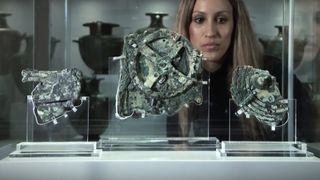Researchers propose a 'day zero' for the oldest computer ever discovered
Though the calibration date for the Antikythera mechanism is still a little hazy.

Built some time between 200 BC and 60 BC, the Antikythera mechanism is the oldest known computer mechanism in existence. This ancient, geared device for tracking the heavens is in pretty bad shape after all that time.
But, despite the rust, researchers may have finally revealed a possible date it was first set ticking—also known as "Day Zero."
The mechanism is actually a hand-wound clock, used to calculate the sun, moon and planets' movements, and to predict eclipses. It was discovered over a century ago in a shipwreck, says NewScientist, after a gale blew divers off-course to the barren islet of Antikythera—hence the name.
Since then, the mechanism has made waves in our understanding of how technologically advanced the ancient Greeks were. It's proven that their technical ability was far beyond what we initially thought. Archimedes himself may have even had a hand in the original design of mechanisms like this one, since it has links to his home city of Syracuse.
Mathias Buttet, Director of Research and Development at Hublot, who helped recreate a wearable version of the mechanism says the "Antikythera mechanism includes ingenious features which are not found in modern watchmaking." That all points to the ancient Greeks having been better at measuring time than we ever imagined.
But as with any mechanism that measures, calibrations are needed. For a clock like this the calibrations would require a start date to ensure the device’s accuracy.




Recent advancements have pointed to the calibration date having been around the time the moon was in its apogee position, its furthest position in orbit from the Earth, which causes a kind of solar eclipse.
The biggest gaming news, reviews and hardware deals
Keep up to date with the most important stories and the best deals, as picked by the PC Gamer team.
Aristeidis Voulgaris of the Thessaloniki Directorate of Culture and Tourism in Greece now supposes the calibration date was around 23 December 178 BC, backing it up with the fact that a bunch of other culturally important astronomical events happened simultaneously right just then. The winter solstice is one event that helped push the team toward their conclusion, particularly as the mechanism’s inscription mentions it specifically.

Best CPU cooler: keep your chip chilled in style
Best PC fans: super-silent and plastered in RGB
Best PC cases: big, little, and everything in-between.
Four independent calculations have been made by other researchers, which place the device's calibration closer to 204 BC, however. These calculations relied on the period where the mechanism’s astronomical predictions were most accurate, but place the date in the summer. That potential has researchers scratching their heads over the prominence of the device’s winter solstice inscription.
Looks like there's still a way to go before researchers agree on a day zero for the Antikythera mechanism, then. Still, it's good to know this ancient precursor to modern tech isn't being forgotten about, even after all these years.

Screw sports, Katie would rather watch Intel, AMD and Nvidia go at it. Having been obsessed with computers and graphics for three long decades, she took Game Art and Design up to Masters level at uni, and has been rambling about games, tech and science—rather sarcastically—for four years since. She can be found admiring technological advancements, scrambling for scintillating Raspberry Pi projects, preaching cybersecurity awareness, sighing over semiconductors, and gawping at the latest GPU upgrades. Right now she's waiting patiently for her chance to upload her consciousness into the cloud.
Most Popular






